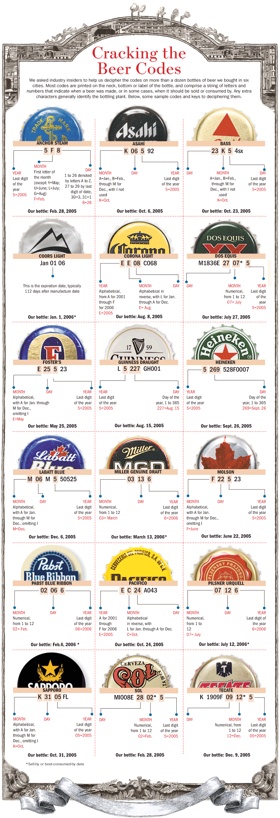Extremely important information about our beer - which should not be confined to Saturday WSJ readers only. I happen to have a bottle of Anchor Steam in the refrigerator: the code is 6JC. Translated - Jan 3rd, 2006. Not bad. Recently I got some Bass Ale, and haven't thrown the empty bottle out yet. 11F5 3SK. Translates into June 11th, 2005. No wonder it wasn't the best tasting Bass Ale. Not quite skunk beer, but close. I think I'm going to print the graphic, and keep it in my wallet - unfold it whenever I purchase beer. Well, maybe.
WSJ.com - The Search for Fresh Beer
To identify when bottles and cans need to be yanked from the shelves, many brewers imprint them with cryptic letters and numbers that distributors can translate. The trouble is they look more like hieroglyphics to beer drinkers, and most makers don't decipher them for consumers. But with the help of industry insiders and analysts, we cracked the codes, studying bottles purchased across the country to determine the key dates for 18 big brews.t turns out there's some pretty old beer out there. The suspect suds reared their not-so-foamy heads at a wide variety of stores. We decoded an Anchor Steam bought in New York and found it to be 10 months old -- the same age as a Bass Ale we purchased in Salem, Ore. In Phoenix, though, we picked up a Dos Equis barely two weeks from the brewery.
Not that beer shoppers would be able to tell. Take Sapporo, a Japanese beer we purchased in Los Angeles, which was imprinted with "K1205FL" on the bottom. Lost in translation? Well, the code indicates the beer was made Oct. 12, 2005. In the case of Sapporo, the first letter represents the month of manufacture: "A" for January, "B" for February and so on, through "M" for December. (As if the system weren't complicated enough, this one, like many of these codes, has an extra twist: The month code skips over the letter "I" and uses "J" for September.) The next two digits, "12," refer to the day of the month, and the two numbers after that, "05," are the last two digits of the year.
...Why make it so complicated? Most brewers don't really want consumers to know when their beer was made. "We believe in competing on the basis of the taste of our beer, not its age," says Fritz Maytag, owner of Anchor Brewing in San Francisco. The Anchor Steam brewer, which uses cryptic three-character codes like "5NV," says consumers can look for the key on the Web. "We don't go out of our way to tell everyone how old it is."
...Because temperature and motion can also affect the rate of oxidation, there's no simple answer to how long it takes a beer to go stale. Some makers, like Asahi, say their beer tastes just fine for up to a year. Sierra Nevada, on the other hand, recommends drinking it within 90 days of bottling. Most work with a range of four to six months, and few go beyond nine. Some beer-industry experts say this is especially challenging for imported beers, many of which travel to the U.S. market on ships on which cargo is not refrigerated.
Each brewery specifies when its beers should be pulled from the shelves. Most retailers, such as grocery stores and liquor stores, actually have little to do with this. The job falls to locally based distributors, which usually fall into two categories -- companies that carry Anheuser-Busch products and those that don't.
For these distributors, pulling old beers off store shelves is a big job. Makers say they require these distributors to follow strict procedures, and have their own inspectors to spot-check the work. Distribution-company employees are taught how to translate the codes into dates. Most cases of beer carry the same information that appears on individual cans and bottles, whether it's a code or an explicit date. Beers that are too old are to be removed from the shelves and destroyed.
Tags: beer


If you have trouble printing the larger version of the chart, let me know. I sort of goofed up the link.